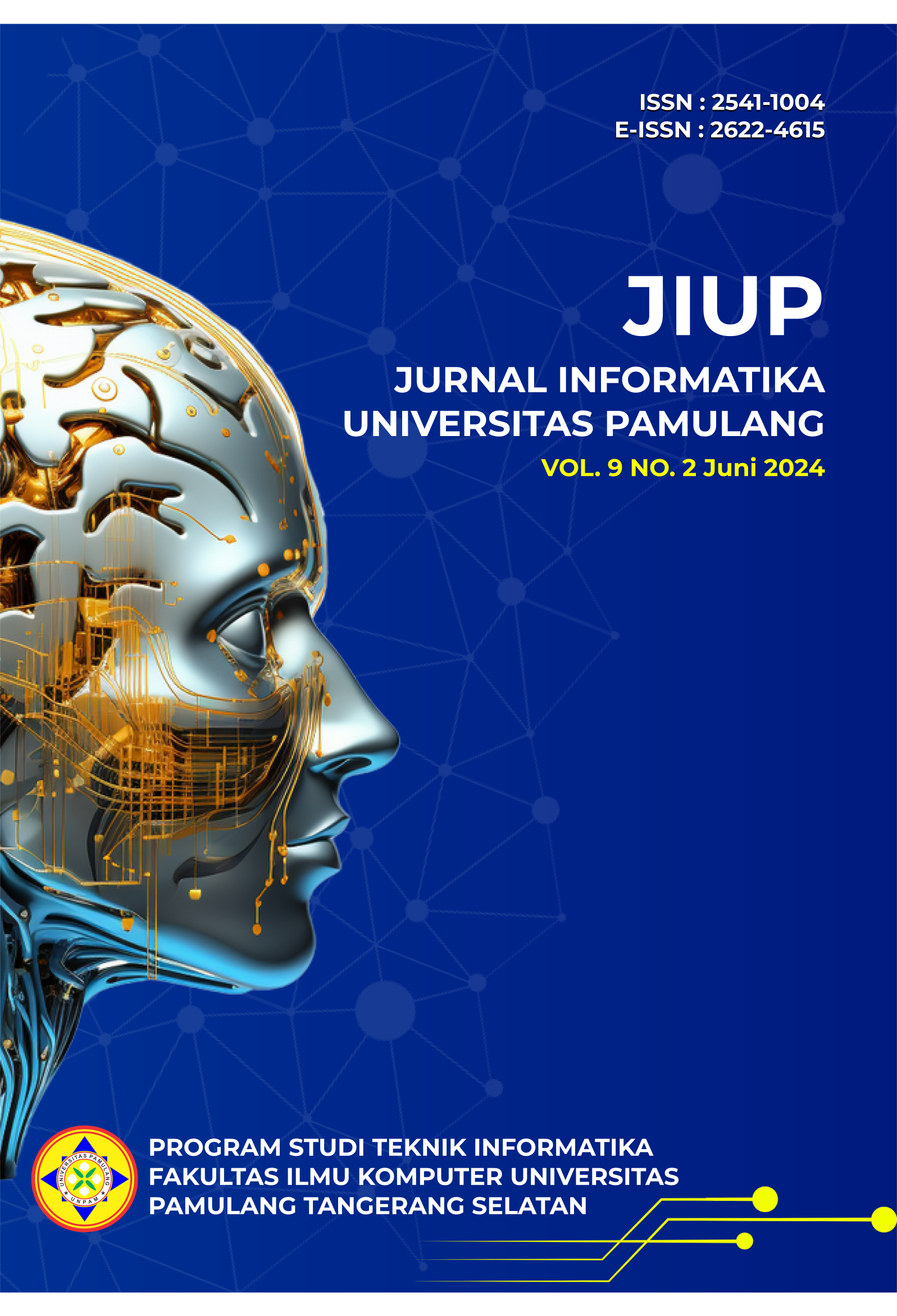Implementasi Metode Naive Bayes untuk Klasifikasi Kondisi Gizi Balita
DOI:
https://doi.org/10.32493/informatika.v9i2.39676Keywords:
Classification, Naive Bayes, Nutritional Conditions, RADAbstract
The determination of a toddler's nutritional status involves calculating weight and height based on age. Naïve Bayes is a machine learning algorithm for classification problems in data mining that utilizes probability mathematics (also known as Bayes' theorem) to distinguish between different classes. This system is designed to facilitate the nutrition staff at the Pajar Bulan Village Health Center in more accurately storing data and automatically determining the nutritional status of toddlers. The system is developed using the Rapid Application Development (RAD) method, which comprises three phases: requirements planning, design workshop, and implementation. The classification system for toddler nutritional status using the Naive Bayes algorithm aims to provide more accurate information to address malnutrition in toddlers. The data processing with the Naive Bayes algorithm results in the development of a system for classifying the nutritional status of toddlers at the Pajar Bulan Village Health Center.References
An, K., Imania, N., & Bariah, S. K. (2019). Rancangan pengembangan instrumen penilaian pembelajaran berbasis daring. PETIK: Jurnal Pendidikan Teknologi Informasi Dan Komunikasi, 5(1), 31–47.
Arfanda, I., Ramdhan, W., & Yusda, R. A. (2021). Naive Bayes Dalam Menentukan Penerima Bantuan Langsung Tunai Digital Transformation Technology ( Digitech ) | e-ISSN : 9999-9999. Digital Transformation Technology (Digitech), 1(1), 9–16. https://doi.org/http://10.47709/digitech.v1i1.1091
Budiman, D. A., Nugraha, D. M., & Margahayu, S. A. (2019). APLIKASI RAPORT ONLINE BERBASIS WEB MENGGUNAKAN FRAMEWORK CODEIGNITER ( Studi Kasus di SMK ANGKASA 1 MARGAHAYU ). Jurnal Computech & Bisnis, 13(2), 112–121. https://doi.org/https://zenodo.org/records/3631061
Damuri, A., Riyanto, U., Rusdianto, H., & Aminudin, M. (2021). Implementasi Data Mining dengan Algoritma Naïve Bayes Untuk Klasifikasi Kelayakan Penerima Bantuan Sembako. Jurnal Riset Komputer, 8(6), 219–225. https://doi.org/10.30865/jurikom.v8i6.3655
Febriansyah; Muntari, S. (2023). SISTEM PENUNJANG KEPUTUSAN PEMILIHAN USTAD USTADZAH TERBAIK MENGUNAKAN METODE SIMPLE ADDICTIVE WEIGHTING ( SAW ) PADA MTS DEMPO Diterima : Diterbitkan : Sistem Penunjang Keputusan ……. Jurnal Khatulistiwa Informatika, 11(2), 103–109.
Febriansyah; Murniati, N., Hasyim, H., Etrawati, F., Razak, R., Budiastuti, A., & Yuliana, I. (2023). IDENTIFIKASI FAKTOR RESIKO STUNTING DAN UPAYA PENCEGAHAN DENGAN INTERVENSI SECARA KOLABORATIF DI KABUPATEN EMPAT LAWANG. Martabe : Jurnal Pengabdian Masyarakat, 6(4), 1510–1515.
Laola, V. (2021). Rancang Bangun Aplikasi Inventory Material Jasa Pelaksana Kontruksi PT . Bawan Permai Group Berbasis Website. JOINTECOMS : Journal of Information Technology and Computer Science, 1(June). https://doi.org/https://doi.org/10.47111/jointecoms.v1i1.2510
Muksin, A. Z. ; M. (2018). Penerapan metode naive bayes untuk klasifikasi status gizi (studi kasus di klinik bromo malang). Seminar Nasional Sistem Informasi (SENASIF), 1204–1208.
Muntari, S. F. (2022). Sistem Pakar Diagnosa Penyakit Pada Perokok menggunakan Metode Teorema Naive Bayes. Building of Informatics, Technology and Science (BITS), 3(4), 686–695. https://doi.org/10.47065/bits.v3i4.1196
Purwati, N. (2018). Deteksi Gizi Buruk Pada Balita Berdasarkan Indeks Antropometri Menggunakan Algoritma Naive Bayes. Bianglala Informatika, 6(1), 2016–2019. https://doi.org/https://dx.doi.org/10.31294/bi.v6i1.5907
Reni Merta Kusuma, R. A. H. (2018). ANTROPOMETRI PENGUKURAN STATUS GIZI ANAK USIA 24-60 BULAN DI KELURAHAN BENER KOTA YOGYAKARTA Reni Merta Kusuma , Rizki Awalunisa Hasanah. Medika Respati, 13(November). https://doi.org/https://doi.org/10.35842/mr.v13i4.196
Suprianto, S. (2020). Implementasi Algoritma Naive Bayes Untuk Menentukan Lokasi Strategis Dalam Membuka Usaha Menengah Ke Bawah di Kota Medan ( Studi Kasus : Disperindag Kota Medan ). Urnal Sistem Komputer Dan Informatika (JSON), 1(2), 125–130. https://doi.org/10.30865/json.v1i2.1939
Yahya, H. A. Q. (2020). Rancang bangun aplikasi perpustakaan menggunakan. Jurnal Sistem Informasi Dan Sains Teknologi, 2(2), 1–8. https://doi.org/https://doi.org/10.31326/sistek.v2i2.663
Yoshe, M., & Hadikurniawati, W. (2021). Implementasi Metode Naive Bayes Classifier Untuk Klasifikasi Status Gizi Stunting Pada Balita. Jurnal Ilmiah Informatika, 09(01). https://doi.org/https://doi.org/10.33884/jif.v9i01.3741
Zulfachmi, T. P. (2021). Survey Paper : Perbandingan Metode Pengembangan Perangkat Lunak. Jurnal Ilmiah Penelitian Dan Penerapan Teknik Informatika Dan Sistem Informasi, 10(01), 6–12. https://doi.org/https://doi.org/10.52771/bangkitindonesia.v10i1.153
Downloads
Published
Issue
Section
License
Copyright (c) 2024 Febriansyah Febriansyah

This work is licensed under a Creative Commons Attribution-NonCommercial 4.0 International License.
Authors who publish with this journal agree to the following terms:
- Authors retain copyright and grant the journal right of first publication with the work simultaneously licensed under a Creative Commons Attribution-NonCommercial 4.0 International (CC BY-NC 4.0) that allows others to share the work with an acknowledgement of the work's authorship and initial publication in this journal.
- Authors are able to enter into separate, additional contractual arrangements for the non-exclusive distribution of the journal's published version of the work (e.g., post it to an institutional repository or publish it in a book), with an acknowledgement of its initial publication in this journal.
- Authors are permitted and encouraged to post their work online (e.g., in institutional repositories or on their website) prior to and during the submission process, as it can lead to productive exchanges, as well as earlier and greater citation of published work (See The Effect of Open Access).
Jurnal Informatika Universitas Pamulang have CC-BY-NC or an equivalent license as the optimal license for the publication, distribution, use, and reuse of scholarly work.
In developing strategy and setting priorities, Jurnal Informatika Universitas Pamulang recognize that free access is better than priced access, libre access is better than free access, and libre under CC-BY-NC or the equivalent is better than libre under more restrictive open licenses. We should achieve what we can when we can. We should not delay achieving free in order to achieve libre, and we should not stop with free when we can achieve libre.
Jurnal Informatika Universitas Pamulang is licensed under a Creative Commons Attribution-NonCommercial 4.0 International (CC BY-NC 4.0)
YOU ARE FREE TO:
- Share : copy and redistribute the material in any medium or format
- Adapt : remix, transform, and build upon the material for any purpose, even commercially.
- The licensor cannot revoke these freedoms as long as you follow the license terms





